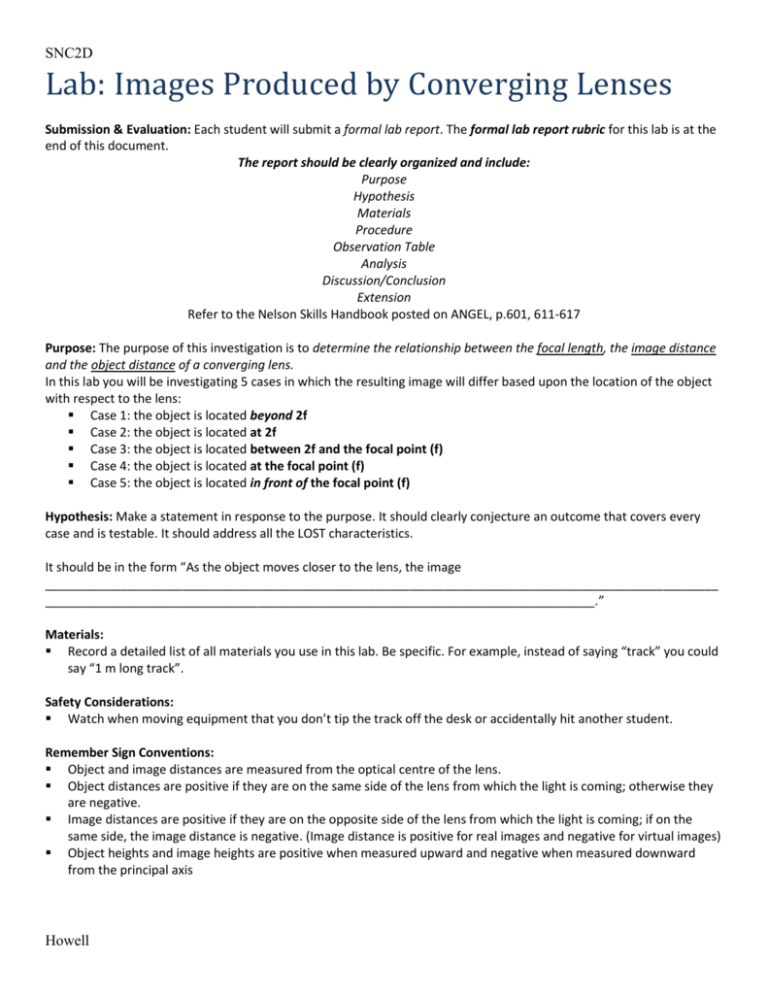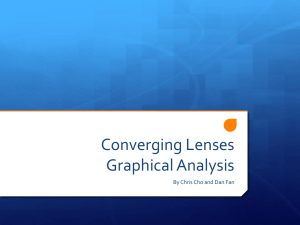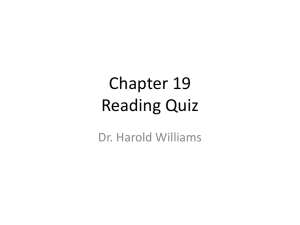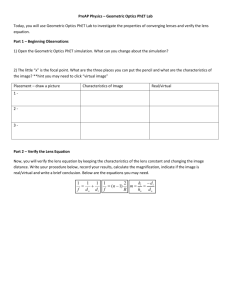Converging Lens Lab
advertisement

SNC2D Lab: Images Produced by Converging Lenses Submission & Evaluation: Each student will submit a formal lab report. The formal lab report rubric for this lab is at the end of this document. The report should be clearly organized and include: Purpose Hypothesis Materials Procedure Observation Table Analysis Discussion/Conclusion Extension Refer to the Nelson Skills Handbook posted on ANGEL, p.601, 611-617 Purpose: The purpose of this investigation is to determine the relationship between the focal length, the image distance and the object distance of a converging lens. In this lab you will be investigating 5 cases in which the resulting image will differ based upon the location of the object with respect to the lens: Case 1: the object is located beyond 2f Case 2: the object is located at 2f Case 3: the object is located between 2f and the focal point (f) Case 4: the object is located at the focal point (f) Case 5: the object is located in front of the focal point (f) Hypothesis: Make a statement in response to the purpose. It should clearly conjecture an outcome that covers every case and is testable. It should address all the LOST characteristics. It should be in the form “As the object moves closer to the lens, the image __________________________________________________________________________________________________ ________________________________________________________________________________.” Materials: Record a detailed list of all materials you use in this lab. Be specific. For example, instead of saying “track” you could say “1 m long track”. Safety Considerations: Watch when moving equipment that you don’t tip the track off the desk or accidentally hit another student. Remember Sign Conventions: Object and image distances are measured from the optical centre of the lens. Object distances are positive if they are on the same side of the lens from which the light is coming; otherwise they are negative. Image distances are positive if they are on the opposite side of the lens from which the light is coming; if on the same side, the image distance is negative. (Image distance is positive for real images and negative for virtual images) Object heights and image heights are positive when measured upward and negative when measured downward from the principal axis Howell SNC2D Procedure: You must come up with the procedure for this lab and record it in your lab report. Remember, procedure steps should be simple, present-tense, actions that another student could complete in order to get your same results. The first couple have been completed for you below. You still need to include them in your lab report. 1. Determine the focal length of your converging lens. Set your ray box to send out a wide beam of light and hold it about a metre away from your lens. Use your screen to locate the point on the opposite side of the lens where the light is focused to a point. Measure the distance between the screen and the lens: f = ______ 2. Turn the lens around and repeat step 1 (to verify your measurement) f = ______ 3. Calculate an average of both f measurements. favg= ______ 4. Using this average value, calculate the following object distances and record them in the attached table: 2.5f = ___ 2.0f = ___ 1.5f = ___ f = ___ 0.5f = ___ 5. Start adding your own steps here. Observations: Complete the observation table below and perform relevant calculation. Remember sign conventions! Case Object L O S T 1/ do 1/ di 1/ do + 1/f Distance (di), cm (hi), 1/ di (do), cm cm 1 2.5f = ___ 2 2.0f = ___ 3 1.5f = ___ 4 f 5 0.5f = ___ = ___ Show sample calculations in your lab report. Analysis: 1. As the object moves closer the lens what regular changes occur: to the size of the image? to the distance of the image? to the attitude of the image? Howell SNC2D 2. At what object distance was it difficult, if not impossible, to locate a clearly focused image? 3. Where would you place an object in relation to the principal focus to form a: real image? virtual image? 4. How does the value of 1/f relate to the value of (1/ do + 1/ di ) for the cases involving real images? 5. How does the value of 1/f relate to the value of (1/ do + 1/ di ) for the cases involving virtual images? 6. Calculate the theoretical di for each case and find your percent error. Discussion/Conclusion: 1. Why does the method in step 1 work for finding the focal length of the lens? (hint – check out the rules for rays in a converging lens and draw a ray diagram to help you explain your reasoning) 2. The thin-lens equation is 1 1 1 . Has your experiment confirmed or contradicted this relationship? f d o di 3. Can you provide some suggestions on how to increase the accuracy of the experiment? (Consider parts that you found difficult) 4. Based on your investigation and findings – what is the relationship among the focal length, the image distance and the object distance of a converging lens? Extension: Match the following real-world device listed below to the characteristics you observed in your 5 object/image orientations. Object Distance Image Location and Device (In terms of f ) Attitude Photocopier (Image is the same size, and real) Hand Magnifier (image is larger and virtual) Overhead Projector (image is larger and real) 35 mm Camera (image is smaller and real) Spotlight (parallel light – there is no image) Howell SNC2D Category Level 4 Level 3 Level 2 Level 1 Below Level 1 Knowledge Understanding Concepts and Terminology. Overall lab submission demonstrates thorough and insightful understanding of concepts related to refraction. No submission or below Level 1 expectation. Thinking Hypothesis clearly conjectures the relationship between variables that covers every case listed in Purpose. No submission or below Level 1 expectation. Procedure steps logical and reasonable. They could be easily followed by another person. No submission or below level 1 expectation. Observation table is complete and correct with sample calculations shown. No submission or below level 1 expectation. All 6 Analysis questions are complete and correct, with thorough supporting evidence. No submission or below level 1 expectation. All 4 Discussion answers are thorough, logical, complete and correct. No submission or below Level 1 expectation. Communication All required elements are present and additional elements that add to the report (e.g., thoughtful comments, graphics) have been added and the report is on time. No submission or below Level 1 expectation. Lab is well organized using the proper format, relevant vocabulary, mathematical conventions and units. No submission or below Level 1 expectation. Application Extends refraction of converging lenses to real-life applications. Complete and correct for all 5. Howell No submission or below Level 1 expectation.







